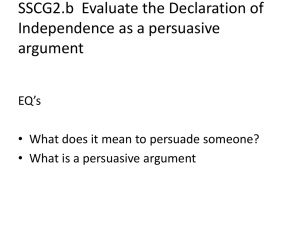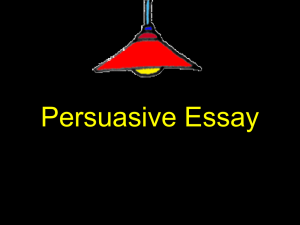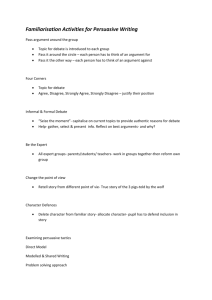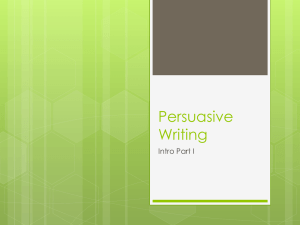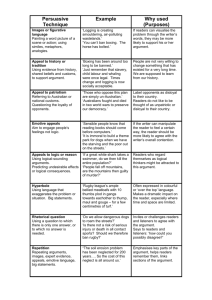They Say / I Say: Academic Writing Moves
advertisement
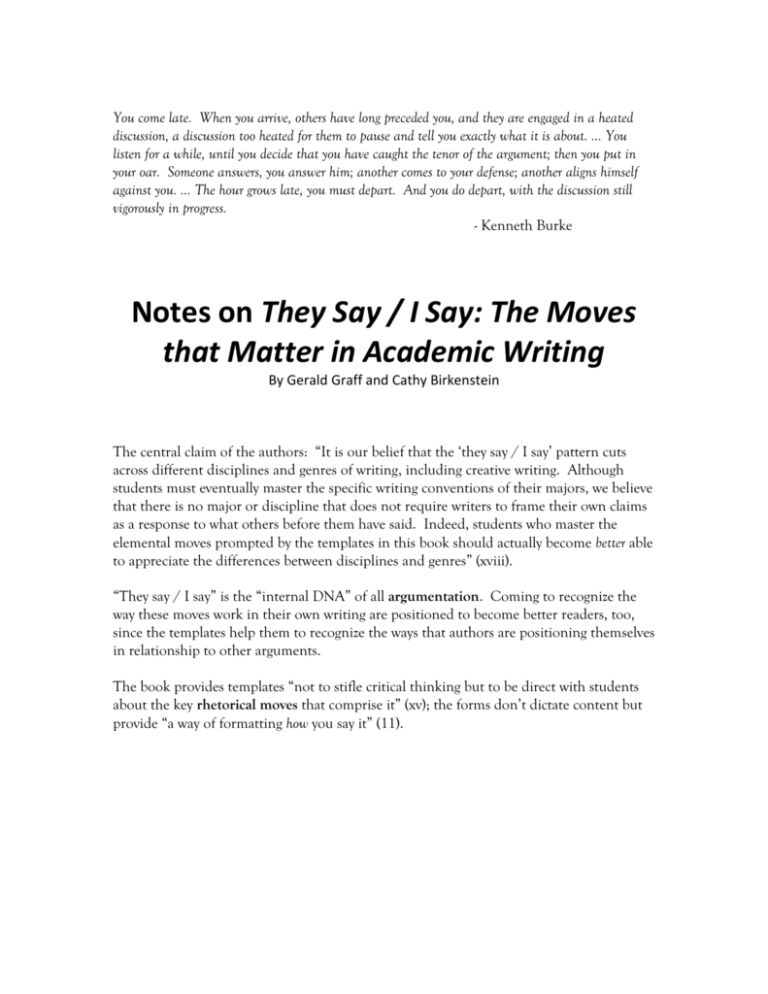
You come late. When you arrive, others have long preceded you, and they are engaged in a heated discussion, a discussion too heated for them to pause and tell you exactly what it is about. … You listen for a while, until you decide that you have caught the tenor of the argument; then you put in your oar. Someone answers, you answer him; another comes to your defense; another aligns himself against you. … The hour grows late, you must depart. And you do depart, with the discussion still vigorously in progress. - Kenneth Burke Notes on They Say / I Say: The Moves that Matter in Academic Writing By Gerald Graff and Cathy Birkenstein The central claim of the authors: “It is our belief that the ‘they say / I say’ pattern cuts across different disciplines and genres of writing, including creative writing. Although students must eventually master the specific writing conventions of their majors, we believe that there is no major or discipline that does not require writers to frame their own claims as a response to what others before them have said. Indeed, students who master the elemental moves prompted by the templates in this book should actually become better able to appreciate the differences between disciplines and genres” (xviii). “They say / I say” is the “internal DNA” of all argumentation. Coming to recognize the way these moves work in their own writing are positioned to become better readers, too, since the templates help them to recognize the ways that authors are positioning themselves in relationship to other arguments. The book provides templates “not to stifle critical thinking but to be direct with students about the key rhetorical moves that comprise it” (xv); the forms don’t dictate content but provide “a way of formatting how you say it” (11). Part I. “They Say” The simplest template for academic writing is this one: “They say ____; I say ____.” In other words, writing—all writing—is about listening to others, summarizing their views, and responding with your own idea. It’s about more than asserting your own position—it’s about placing that position within the conversation that’s already been taking place. The conversation doesn’t have to be a response to great authors or experts or some well-known person—it can be a response to some interior struggle, or to your sister. But there’s got to be some tension: When I was a kid, I thought that all people could succeed if they just tried hard enough. The older I get, though, the more I see that our chances for success are greatly restricted by our location, our upbringing, and the institutions we participate in. The goal of writing like this is NOT to “play it safe.” Good persuasive writing is not about repeating the truths that are already accepted by your audience; instead, persuasive writing can only have a purpose if it challenges some belief your readers hold. However, this expectation doesn’t mean that you have to make ridiculous claims—and in some cases, agreement can be a part of persuasive writing, if you have something NEW to add to the accepted view: Her argument that _____________ is supported by new research/my own experience/changing attitudes that ______________. Changing the world begins with a sentence like this: “Of course, someone may object that ________.” This structure works well for academic writing, but it’s not only about the academy—it’s also a good model that helps us realize we need to listen to others different from us and find ways of engaging with them thoughtfully and respectfully. According to Graff and Birkenstein, argumentative writing needs to identify WHO it’s responding to, early in the writing: “To keep an audience engaged, a writer needs to explain what he or she is responding to—either before offering that response or, at least, very early in the discussion. Delaying this explanation for more than one or two paragraphs in a very short essay, three or four pages in a longer one, or more than ten or so pages in a book-length text, reverses the natural order in which readers process material” (18). So, start with what they say. (Then follow up with what an indication of what you say—what you intend to ADD to the topic. Otherwise it feels like you’re just going to deliver the party line.) An illustrative quotation, a surprising fact/statistic, a personal experience can work as a way of introducing what they say, as long as it illustrates the view that you’re addressing. Templates for introducing the standard view Americans today tend to believe that ____. Conventional wisdom is that ____. The standard way of thinking about ___ is that _____. My whole life I have heard it said that _____. Many people have agreed with ____, who claims that ______. Presenting the standard view as your own I’ve always believed that ______. When I was a child, I used to believe that ___________. Presenting an argument that is often implied Although none of them have ever said so directly, my teachers have often given me the impression that ________ Though they may not admit it, _______ often take for granted that ________. Setting up sides of an issue In discussions of ___, one controversial aspect has been ______. On the one hand, ______ argues __________. On the other hand, _________ suggests that ___________. [Because of ________,] My view is ___________. When it comes to the topic of ______________, most of us agree that ____________. But the agreement usually ends when we reach the question of ____________. While some believe that ______________, others feel that ____________. As you write, you should return to the view that you’re responding to, which helps maintain a sense of purpose and significance for the writing. And it helps your readers see that you’re honestly responding rather than just presenting information about a topic. Summarizing the positions of others A summary is not your response, your opinion, or your griping about the topic. And it’s also not just a string of quotations from the text. It’s tricky: “A good summary requires balancing what the original author is saying with [your] own focus. Generally speaking, a summary must be at once true to what the original author says while at the same time emphasizing those aspects of what the author ways that interest you.” If you do an honest job of summarizing, your reader shouldn’t be able to tell whether you agree or disagree with the author’s position. Don’t fall into the “closest cliché” trap—that’s when “what gets summarized is not the view the author in question has actually expressed, but a familiar cliché that the writer mistakes for the author’s view.” This is reducing an argument to a trope or cliché or truism that is much simpler than the real argument presented. Since a text will often provide relevant information about a variety of topics, you’ll want to summarize it in relationship to the topic that you’re addressing. This is not simplifying in the dishonest or reductive sense but merely stressing those elements/points which are most relevant to your argument. Also, summarizing the text in terms of the topic that you’re focused on will help you work from the big picture down to the relevant details—rather than just providing a “list summary” of points with no main focus. (List summaries are typically joined by “and then,” “next,” “after that,” etc. A list summary is what your four-year-old nephew gives you when he summarizes his trip to the museum: “We saw bears! And then we went to a room that had a bunch of igloos in it! And then we saw a dinosaur bone! And then there was a room that had dead people in it!” In a summary like this, it’s not clear why the speaker is choosing to summarize specific points of the experience.) Balance objectivity with accuracy. In persuasive writing, most authors are not merely “stating” something—they’re also participating in a conversation by agreeing and disagreeing, providing examples, challenging claims, etc. As a result, a good reader will recognize the stance of the author and provide phrasing to indicate that stance in their own summary. Words to show that the author is making a claim: argue, assert, believe, claim, emphasize, insist, observe, suggest Words to show that the author agrees with someone else’s idea: acknowledge, admire, agree, corroborate, endorse, extol, praise, do not deny, verify Words to show questioning or disagreement: complain, complicate, contend, contradict, deny, disavow, refute, challenge, question, Words to show that the author is making a recommendation: advocate, call for, demand, encourage, implore, plead, urge, warn For example, in most persuasive writing, the authors aren’t just “talking about” an idea. Instead, you might summarize by writing that Jones disagrees with authorities on _______ by providing evidence to support his claim that _________, and he wants to encourage his readers to ___________ as a result of his assertions. Crafting quotations to support your argument When building on ideas from others, the biggest danger is not in avoiding quotations altogether, nor is it in using too many of them; instead, the biggest danger is assuming that a reader will understand how the quote supports your argument. Avoid this danger by building quotation sandwiches—the top slice gives the reader information to understand the quote, and the bottom slice helps the reader understand how the quotation is relevant to your own ideas. Templates for setting up and following up on quotations. Basically, X is saying ____________. In other words, X believes ____________. In making this comment, X argues that ______________. Some quotations may not need a lot of set up. But those that are long and complex, or filled with details or jargon, or that require additional complexities (like metaphors), are especially likely to require a good bit of front-loading before you insert the quotation. Part II. “I Say” Okay, so you’ve figured out how to fairly restate what somebody else is saying. But that’s just the beginning. For persuasive writing, you also want to be able to add something to the conversation. There are three basic ways to respond: I agree. I disagree. I both agree and disagree. Though these ways to respond seem pretty basic, in fact they become even more important as your writing becomes more complex: readers need a way to see how your ideas fit on the roadmap they already have: are you going in the same direction as they are? Are you going in a different direction? Are you taking a new route to get to the same place? And why? Merely agreeing, or merely disagreeing, is not enough. You’ve also got to say why it matters. Templates for disagreeing: I think X is mistaken because she overlooks ____________. X’s claim that _____________ rests upon the questionable assumption that ___________. In light of recent research showing __________________, I disagree with X that _______________. X contradicts himself. On one hand he seems to suggest that __________ while at the same time he also asserts that _________________. By focusing on ___________, X distracts from the real problem of _______________. Templates for agreeing I agree with X that ________________ because my own experience ________________ confirms it. Recent studies about _______________ support X’s point that _____________. X’s writing about _________________ helps to shed light on the difficult/unrelated topic of ________________. Since I agree with X that _______________, we need to reassess the popular belief that ___________. Most persuasive writing, then, walks a line between texts that line up with the author’s viewpoint and those which complicate or contradict it. Usually, agreeing with some perspective also means disagreeing with some other way of looking at things. Templates for agreeing and disagreeing Although I disagree with X’s main point, I concede that his point about ____________ is persuasive. Although I agree with X up to a point, I cannot accept her overall point that ____________. Whereas X provides ample evidence that __________________, X and Z’s research on _________________ convinces me that _______________ instead. A template for speculative exploration I have mixed feelings about the text. On one hand, I agree with X that _______________. On the other hand, I find his claim that __________________ is problematic. Placing yourself clearly in the writing The danger of incorporating the ideas of other writers is that it can become hard for readers to tell where your summary of others’ ideas ends and your own stance begins. As a result, it’s important for you to provide “markers” that help to indicate where you are beginning your own argument. Templates for marking off your own claims My own view, however, is that _______________. I believe, as X may not, that _________________. X’s assertion that __________________ does not fit the facts. Rather, the evidence shows that __________________. [In this sentence you’re using a claim to distinguish your ideas from source X, and then you’re letting the evidence establish your perspective.] You can also distinguish your claims from others’ by embedding their idea within a sentence. This helps to attribute the idea to its source while also providing your position on that idea—all within the same sentence. Tricky, but smart. Templates for embedding [Note that one template helps to distinguish ideas that are different from your own while the other helps you distinguish an idea that supports your own.] I assert that what X calls ______________ is in fact _________________. X’s conclusion that __________________ adds weight to my claim that ___________. Acknowledging naysayers Since persuasive writing is about persuading people to believe something different than they already do, those people will have different attitudes, values, priorities, or interpretations than you do. That’s why you’re writing. And you can build credibility by acknowledging—rather than dismissing or ignoring—the beliefs of your audience. Those beliefs are sometimes counterarguments, and if you don’t address counterarguments then you run the risk of being seen as close-minded. You can even allow yourself to act as a naysayer in a text. Templates for introducting counterarguments At this point I want to raise some objections inspired by the skeptic in me. She feels that I have been ignoring the issue of _________. “______,” she says to me, “____________________.” Some readers, however, may challenge my view that _______________. After all, many believe that _____________________. In truth, my argument about _________ does seem to ignore _____________. But is my idea realistic? What are the chances of it actually being adopted? Does the evidence I’ve provided compellingly show ___________-? Templates for introducing counterarguments held by a specific group of people (liberals, Christians, capitalists) Here many feminists may object that ______________. Biologists, of course, may dispute my claim that _____________. Though not all Christians think alike, a fairly common perspective they hold, in opposition to my own, may be that __________________. Though labeling groups introduces a level of generalization that may be uncomfortable, it also allows for the possibility of connecting your ideas to the larger interaction of ideas. The third example shows a way to avoid overgeneralization while still ascribing a view to a certain group. Answering objections It’s not enough just to acknowledge the views of others—you also need to answer them. And you need to answer them fairly, without mocking or oversimplifying. And your response to the counterargument needs to be more persuasive than the counterargument. “That’s just wrong” is not persuasive, since it’s not backed up with any research or logic or example. And, often, you’ll discover that finding a way to effectively address a counterargument will allow you to refine your own position by giving it greater depth and precision. Giving up group while still holding position Although I admit that ___________, I still maintain that __________ since __________. Proponents are right to point out that _______________. But they exaggerate/misrepresent the evidence when they say ________________. While it is true that _________________, this fact does not necessarily cause/indicate/show that __________________. What if you discover that a counterargument is more persuasive than your stance? Well, this discovery probably means you need to do some major revision. One goal of writing is to help you extend your own thinking, and a fair investigation of the evidence may mean that you learn something new that changes your view. That’s not a bad thing. Part III. Some Additional Considerations Establishing significance If it isn’t clear why your audience should care about your writing, they probably won’t. Since you’re writing to persuade someone to revisit their position on some topic, one of the easy ways to help a reader see the significance of your writing is by helping them see how your claim may differ from their own. If you’re writing about something that everyone already accepts, there’s not much reason to be writing about it. A thesis statement is not a bad place to establish significance by identifying the tension between a group’s current view and the position that you advocate. __________ used to think that ____________. But a shifting focus on ___________ has meant that _______________. This position challenges the work of critics who have assumed that ___________________. Recent studies shed new light on __________, which previous studies had not addressed. If sports enthusiasts stopped to think about it, they might simply assume that most athletes _____________. However, new research/events show that ____________. At first glance teenagers might say __________________. But on closer inspection they might realize _______________________. In addition to identifying which groups of people might care about the topic, you probably also want to explain why they should care. ______ matters because _________. Although ______ may seem unimportant, it is a crucial factor in our society’s investigation of ________________. My discussion of ______________ is in fact addressing the larger matter of ____________. Hey, you might even be able to say that a good thesis statement generally identifies your position in relationship to other positions and then explains why your position on the topic matters. Metacommentary Metacommentary is the stuff in writing that tells the reader how to interpret the ideas you present. It’s a way of guiding the reader through your ideas. In some ways many of these templates provide ways to build metacommentary into your writing. But here are some other places for metacommentary. Templates to clarify and elaborate. You use these because, no matter how clear your argument, sometimes readers will end up on a sideroad. Generally writers assume that the reader is more familiar with the topic than he or she really is. In other words, _____________________. What _______ really means is that __________________. To put it another way, ___________________. Template to prevent misunderstanding My point is not that we should __________________, but that we should ____________. Template to provide a ‘roadmap’ to your structure The first section provides __________________ while the second section _____________. Having just argued that _________________, let us now turn our attention to ___________. Given this information about ______________ we can now begin to investigate the dispute in more detail. Thus, the position of ____________ is ______________. In contrast, the position of ________________ is _________________. Moving from general claims to specific examples For example, _____________________. ________, for instance, shows that _____________. ____________ provides a specific illustration of _____________. Improving the flow Most of these templates are based on some recurring ways of relating ideas to one another. In general you can establish a clearer flow of ideas if you try to show the way that each is connected to the previous idea and to the idea that follows. The words that help you show these connections are called transitions. The most common relationships indicated by transitions are Addition: also, and, besides, additionally Exemplification: after all, for example, to illustrate, specifically Elaboration: by extension, that is, to put it another way, ultimately Comparison: along the same lines, likewise, similarly Contrast: on the other hand, although, but, in contrast, despite the fact that, however, nonetheless Cause and effect: as a result, because, since, so, then, therefore, thus Concession: admittedly, although it is true, granted, of course Conclusion: in short, in sum, to sum up, overall, ultimately Another way to create connection among ideas is by using the pointing words, like “these,” “this,” “such,” “that,” “those”; and like “his,” “her,” “its,” and “their.” Of course, if you use pointing words, make sure your reader can figure out what you’re pointing to! An easy way to do this is by following up words like “this” and “those” with a phrase to rename whatever it is that you’re talking about. Useful exercises from the book (matched to the 1st edition) I.1 --- Identify the ‘positioning phrases’ that the student writer uses. 1.1 --- Developing plausible ‘they says’ for each claim. 2.1 --- Write two summaries of the same excerpt, for two different purposes/focuses. 3.1 --- Identify top slice and bottom slice in someone else’s quotation sandwich. 4.1 --- Identify how the author of the excerpt positions herself in relationship to the stances of those who have come before her. 5.1 --- Identify the markers the author of the excerpt uses to set of her ideas from those of the sources she’s building from. 6.1 --- Plant a naysayer in an excerpt from Schlosser. p. 126 --- Identify the metacommentary tags in the Postman excerpt.

